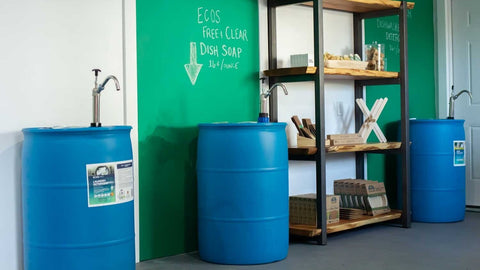The Dark Side of Recycling
We know society is dependent on plastic, and today’s post aims to bring light on how the recycling method is the “third R” in that line of Reduce, Reuse, Recycle priority.
To get us to understand recycling a little better, we’ll dig into why we can’t seem to escape plastics; how the United States (and the state of Hawaii) operationalizes recycling, and what you can do to best prepare your recycling. If you haven’t already, check out our previous post on Bioplastics and Why We’re Not Ready for Them.
Why We Can’t Escape Plastic
In the event that you don’t own your own cow or brew your own beer you’re probably purchasing plastic products or items with plastic packaging every week or so, and no worries there! The journey into a less-wasteful lifestyle can start with our #Wasteless Wednesdays tips, and develop into something that works best for YOU!

I find myself thinking about the quote, “we don’t need a handful of people doing zero waste perfectly. We need millions of people doing it imperfectly” quite a lot, and it’s true! You never know how much your actions can lead someone else to joining in the movement.

A helpful exercise in addressing our plastic problem comes from a college anthropology assignment on consumerism and sustainability. The task was to document purchases made over a week (or try auditing a single day to start!), and categorize the kinds of products purchased and note the amount and type of plastic associated with each product. In all honesty, even thinking about the assignment task kept me from purchasing a gatorade at the convenience store or opting for a banana as a snack, opposed to a Clif Bar. My habits were already changing.
So what kinds of plastic was I mostly dealing with? Check out below
- BAGS: Thin and filmy. Plastic bags are ubiquitous across retail shops, food trucks, grocery stores and more. It seems as though the limit does not exist when it comes to plastic bags… You can even catch them drifting through the wind, and don’t we all feel like that too sometimes?
Solutions!
- BYOB (bring your own bag!) For one, cloth bags are durable. If you’re a one trip from the car to the door kind of person, cloth bags are for you! Save your fingers from twisted tight plastic bags that cut off blood flow for a cloth bag with a thick friendly strap. Even if you rip a seam in a cloth bag, your repair can add a personal touch ! Thirty-One Grocery Totes has a variety of cute prints, sizes and functionalities for reusable bags.
- The Plastic Bag Ban and Disposable Foodware Ordinacne (DFWO) on the island of O‘ahu have officially passed into law and early phases have begun taking effect, meaning these plastic bag options are being halted from a systems level. (woohoo!)

- GROCERIES / PRODUCE: I struggle with this area every trip to the store for a variety of reasons. For one, there are speciality items that tend to come packaged more often than not such as pasta, cereal, beverages, meats, cheeses, tofu, ice cream and beyond. You’re not the only one that’s not churning their own butter.
Solutions!
- 8 Best Reusable Produce Bags of 2021! Or, if you’re super chill, you can omit the produce bag and let your fruits and veggies roam free in your cart. No one’s telling you that you have to wrangle up your apples, cucumbers, limes etc. in their own baggies. Just remember to wash your produce !!
- Bulk buy / refill stores. There are plenty of dry goods that can be purchased in bulk if you bring in your own cleaned reusable container. Take a gander in your grocery store to see where your station is located and what options are available.

Examples:
There are plenty of other notable moments where recyclable material comes into daily life. Beyond plastics there’s a world of paper, cardboard, electronic materials, glass, metals and the list goes on.

Inventory your daily uses for a day or a week and think about what your consumption items and tendencies are. Plan yourself a waste-audit and dig into your specific waste stream. Where can you cut down at the source? What have you sorted out? Where in the world do we go from here?! Kudos if you’ve made it this far, we’ve got more to tap into!
National Recycling Rates
“Confusion at the bin” is a primary problem when it comes to improper recycling. Without standardization for how and what can be recycled, improper practice can cause more harm than good, also known as “wishcycling”. For instance, when glossy paper, like magazines, find their way into bales of regular ol’ office paper, the quality or grade of the bale goes down. If the contamination is bad enough the entire bale (sometimes weighing 1,000 lbs) can be voided. Not good! Also from this, the economic benefit of recycling is diminished, facilities close down, and the problem persists.
Globally approximately 13.5% of materials are recycled, opposed to about a third being tossed into open dumps.
Check Locally oh How 2 Recycle
Recycling in Hawai‘i
Thinking about the finite space available on the small island chain in the pacific, there’s much to question in where does our rubbish and recycling go? Whereas significant improvements with the introduction of laws and ordinances to reduce plastic waste in the consumer stream, many setbacks in recycling and waste processing hinder the state’s sustainability efforts. Honolulu Civil Beat has some excellent resources like the “Are We Doomed” podcast available wherever you stream your podcasts! Listed below are a few of their recycling related podcasts with resources to help answer questions like: What’s on the Recycling in Honolulu list? Brief observation shows not much. Only cleaned plastics #1 and #2, clean and plain office or newspaper, cleaned glass and metals.

What’s interesting is that Hawai‘i ships off recycling materials to Pacific Rim countries like China, Taiwan, Korea, India, and Malaysia - depending on whether those countries are still accepting our shipped materials - or materials are shipped to California for further distribution. In one sense, it seems justifiable to ship off recycling due to the sheer nature that 90% of all food and products are imported to the state of Hawai‘i. Cargo ships bring food in, it would only make sense for the ships to leave with a similar volume, otherwise the carbon cost of empty ships traversing the Pacific also presents it’s eco-challenges.
And finally, H-POWER. From the Hawaiian Electric website, “The primary function of H-POWER (Honolulu Program of Waste Energy Recovery) is to reduce the volume of municipal solid waste on Oahu. The plant is capable of consuming 3,000 tons of garbage per day, reducing the volume of refuse that goes to the landfill by 90%. H-POWER, owned by the City & County of Honolulu, processes the garbage and burns it in furnaces to produce steam that drives a turbine generator. The electricity is sold to Hawaiian Electric and distributed to customers.” You read that right, we burn our trash. Does it lend to self-sufficiency with energy? Yes. Does it host another realm of environmental consequences? Definitely. All the more reason to look into reducing our consumption from the start!

Are We Doomed? Honolulu Civil Beat Podcast
- Where do all of Hawaii’s Recyclables Go?
- Why Doesn’t Honolulu Recycle More?
- Where in the World Do We Send our Recycling?
- What Can We Do With All Our Unrecyclable Plastic?

How to prepare your recycling
1. Sort it- Plastics (by number)
- Paper (office paper, newspaper, make sure nothing’s glossy or sticky!)
- Finished with your yogurt container at work? Make sure you really clean it gooood before placing it in the appropriate bin. Food contamination can throw off the sorting process!
- Plastic Film Recycling - Most facilities do not accommodate plastic bags / film. Search your zip code to find a facility near you!
- Visit your local government website (typically an Environmental Services) for information on bulk pick ups, speciality item disposal, and information specific to your community

Overall, the path to less stress with waste diversion and disposal can be eased by efforts we all take in the choices we make as consumers.
If we shift our minds from thinking about: What can we recover out of the waste stream → How do we keep these materials from becoming waste in the first place? We may begin to see a better horizon.
Remember, the world doesn’t need a bunch of perfect people, just a bunch of people taking small steps in the right direction. Collectively, we can all make a change.
Keep up the good fight!
Maria, Staff Writer
Surf Soap Co. Hawaii
